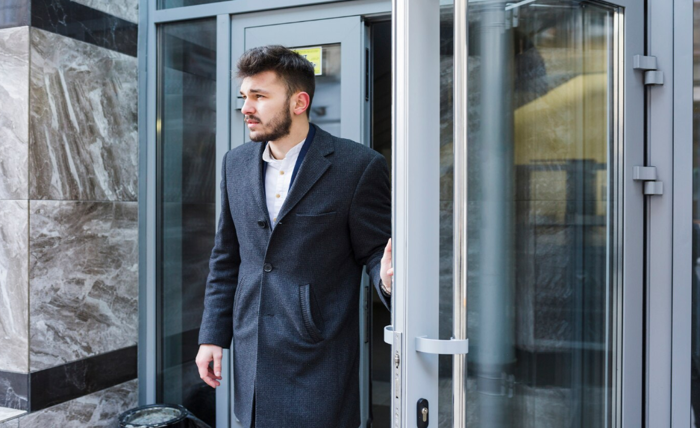
Choosing the right commercial door for your business is a critical decision that impacts security, aesthetics, and functionality—from metal doors offering maximum protection against theft to glass doors providing natural light and visibility, the ideal door type depends on your specific business needs, location, and the impression you want to make on customers.
Automatic Sliding Door Solutions
Automatic sliding doors offer a sophisticated entrance solution for commercial properties, combining accessibility, efficiency, and modern aesthetics. These sliding electric door systems operate via electric motors that sense approaching individuals through motion detectors or pressure pads, automatically sliding open to provide barrier-free entry without manual interaction.
For businesses managing high foot traffic, automatic sliding doors excel at creating smooth people flow while maximizing available space. Unlike swing doors that require clearance area, sliding mechanisms retract into walls or adjacent panels, allowing furniture or displays to be positioned closer to entrances. This space-saving design makes them particularly valuable in compact commercial environments where every square meter counts.
The accessibility benefits are substantial—automatic sliding doors remove physical barriers for individuals with disabilities, helping businesses meet Disability Discrimination Act requirements. They’re equally advantageous for customers carrying goods, staff moving equipment, or parents with pushchairs, creating a universally accessible entrance that enhances customer experience.
Available in various configurations to suit different commercial needs:
- Single sliding doors for space-constrained areas
- Double sliding doors that part in the center for wider access
- Telescopic systems where multiple doors slide simultaneously for maximum opening width
Material options include aluminum, all-glass, timber, and steel frames, with customization possibilities to complement any architectural style. Most sliding doors feature glass panels to maximize natural light penetration and create an inviting, open atmosphere that can enhance retail environments by projecting a sense of activity and professionalism.
Beyond accessibility, automatic sliding doors contribute to energy efficiency by closing promptly when not in use, preventing heat loss that commonly occurs when manual doors are left open. This automatic operation helps maintain consistent interior temperatures and can reduce heating and cooling costs over time.
The technology behind these systems has advanced significantly, with high-tech microprocessor control units enabling seamless integration with building management systems, access control, and fire alarms. Safety features are paramount—built-in sensors detect obstacles and immediately slow or stop door movement to prevent accidents.
Pricing varies considerably based on specifications, with operator mechanisms typically starting around £2,500 plus VAT for installation with proper safety sensors. The door panels themselves range from £700 for standard options to £10,000 for ornate, bespoke designs.
For commercial properties from retail stores and offices to hospitals and hotels, automatic sliding doors represent an investment in customer experience, operational efficiency, and building aesthetics. Their durability—with many systems certified for up to 1,000,000 operation cycles—ensures long-term value despite the higher initial cost compared to manual alternatives.
Metal vs. Glass Security Options
When comparing security options for commercial doors, steel stands out as the premium choice for maximum protection. Steel doors offer exceptional resistance to forced entry attempts, with high-grade steel construction providing unparalleled durability against impacts and break-in tools. They typically last 15-20 years with proper maintenance—significantly longer than glass alternatives which may only last 5-10 years. Steel doors are particularly recommended for businesses in high-crime areas or those requiring robust security measures.
Glass doors, while traditionally considered less secure, have evolved to offer respectable protection when properly designed. Tempered glass doors can withstand considerable force and, when paired with additional locking systems, provide enhanced security while maintaining the benefits of natural light and visibility. For businesses prioritizing both security and aesthetics, modern options include steel-framed glass doors or bulletproof steel doors with ballistic glass windows, combining the structural integrity of steel with transparency. The choice ultimately depends on your specific security needs, with steel offering superior protection and glass providing a balance between security and visual appeal.
Fire-Rated Door Requirements
Fire doors in commercial buildings must meet specific certification standards to effectively contain fire and smoke during emergencies. The most common fire resistance ratings are FD30 (30 minutes) and FD60 (60 minutes), with higher ratings up to FD240 (240 minutes) required in high-risk environments. All commercial fire doors must be certified to British Standards such as BS 476-22:1987 or BS EN 1634-1:2014, ensuring they’ve undergone rigorous testing.
The placement of fire doors is determined by fire risk assessments and building regulations, with installations required at access points through fire-resistant walls, along escape routes, and between designated compartments. Regular maintenance is mandatory—buildings over 11 meters tall require quarterly inspections of fire doors in common areas and annual checks of flat entrance doors. Proper installation is equally crucial, with gap widths between door and frame strictly regulated between 2-4mm to prevent smoke infiltration. For businesses updating their premises, it’s worth noting that by September 2029, only EN standards will be acceptable for demonstrating fire resistance performance, as national standards are being phased out.
Energy Efficiency Features
Energy-efficient commercial doors incorporate several key features that significantly reduce energy consumption while maintaining comfortable indoor temperatures. Airtight seals prevent drafts, while fast opening and closing mechanisms minimize the time doors remain open. High-quality insulation is essential—commercial metal doors often utilize specialized cores made from materials like polystyrene or polyurethane that create a thermal break between interior and exterior environments.
These doors work by reducing thermal transmittance (U-value), helping to retain heated air in winter and reject heat during summer. Additional features may include weatherstripping that seals gaps around door frames, automatic door closers, and smart sensors that optimize operation based on traffic patterns or environmental conditions. For enhanced performance, some doors feature reflective coatings or glazing options like double or triple panes that further improve insulation properties. By implementing these energy-efficient door solutions, businesses can significantly reduce HVAC system load, lower operational costs, and contribute to more sustainable building practices.
Anti-Forced Entry Systems
Forced entry resistance has become a critical consideration for commercial properties, with specialized door systems designed to thwart break-in attempts. Security-rated doors are tested against specific standards such as ASTM F3038-21 and the US Department of State SD-STD-01.01 Rev G, which measure a door’s ability to withstand determined attacks. These ratings quantify resistance time—providing businesses precious minutes for security response while intruders struggle with entry.
Modern anti-forced entry systems come in various configurations to suit different commercial needs:
- Multi-point locking systems encased in drill-resistant manganese that secure doors in multiple directions with up to 20 bolts
- Reinforced steel frames designed to withstand forced entry attempts
- Polycarbonate-based security glazing like ArmorPlast that creates virtually unbreakable barriers while maintaining visibility
- Complete door conversion systems that achieve both UL 752 ballistic ratings and ASTM F3038 forced entry standards for high-security applications
- Advanced access control options including biometric scanners, electronic keypads, and integration with building security systems
- Specialized sliding door solutions like the ASSA ABLOY SL500 with impact-resistant glass and Grade 25 Forced Entry Resistance rating for locations requiring elevated threat protection
Conclusion
Selecting the right commercial door involves balancing multiple priorities—security, energy efficiency, aesthetics, accessibility, and regulatory compliance. Whether you’re outfitting a high-security facility, a stylish retail storefront, or a busy healthcare environment, each door type offers distinct advantages tailored to specific business needs. Investing in quality doors not only safeguards your premises but also enhances the overall customer experience and operational efficiency. By understanding the range of available options and their respective benefits, businesses can make informed decisions that support long-term performance and success.



